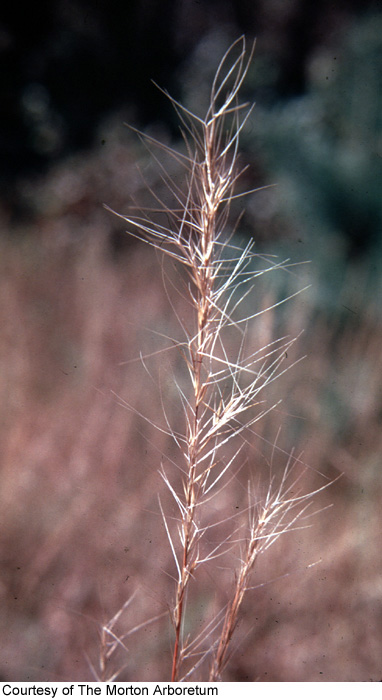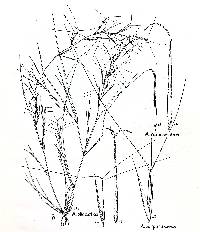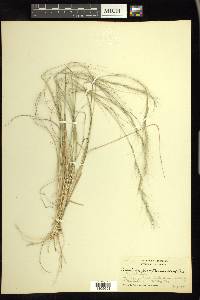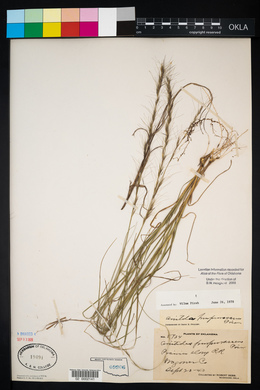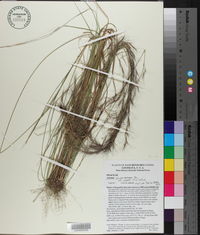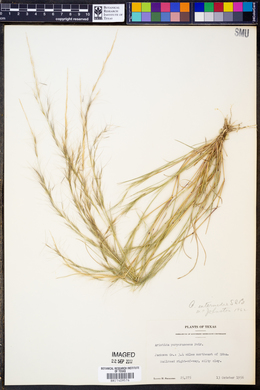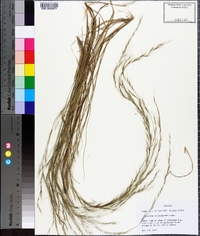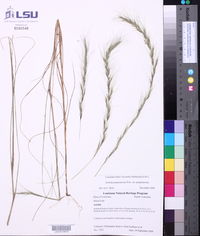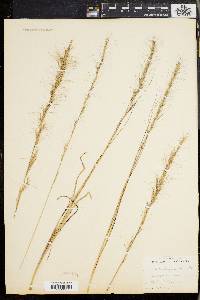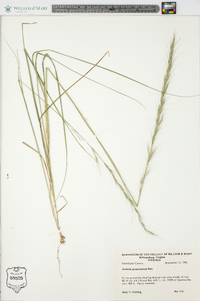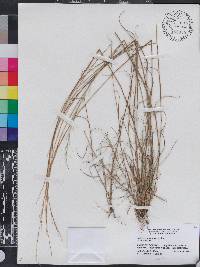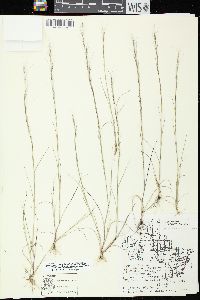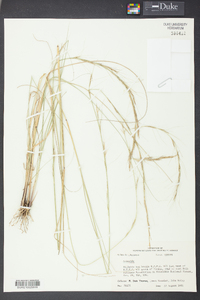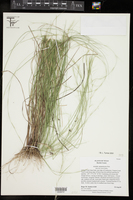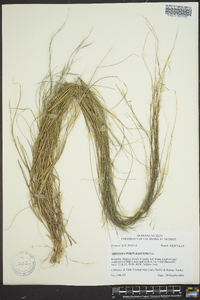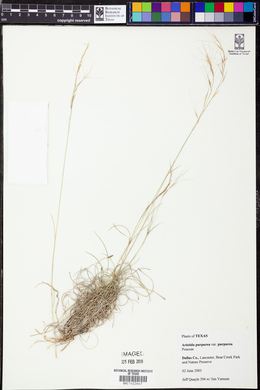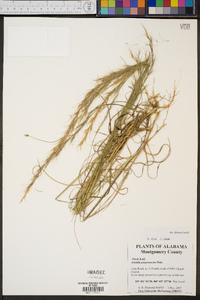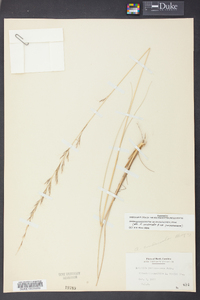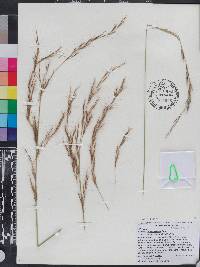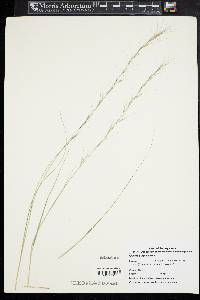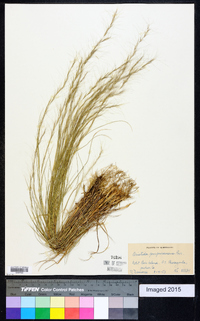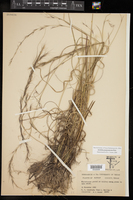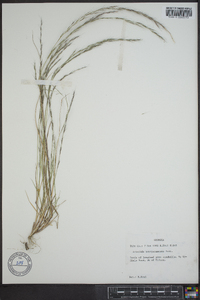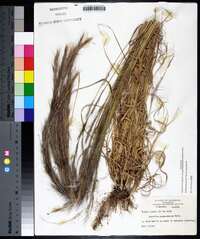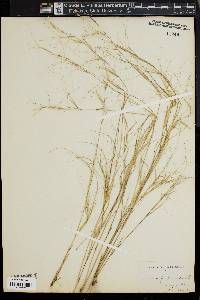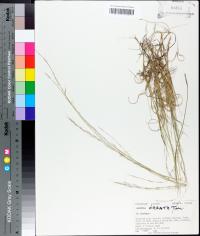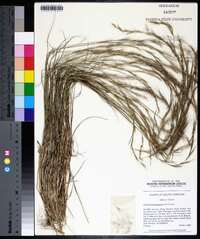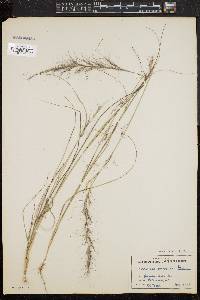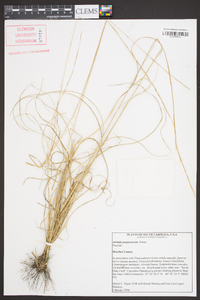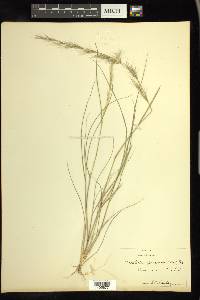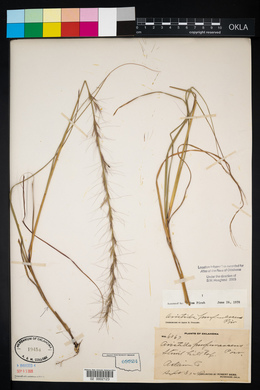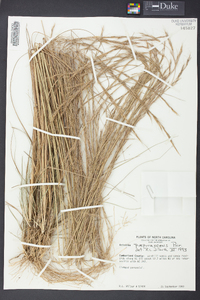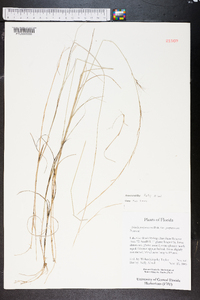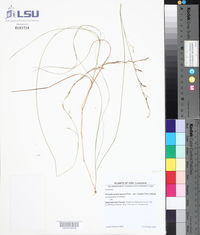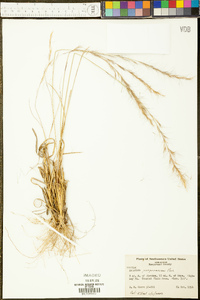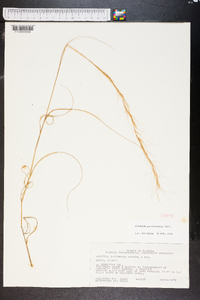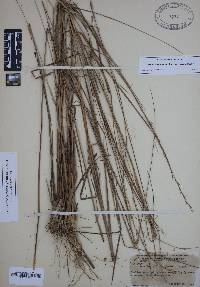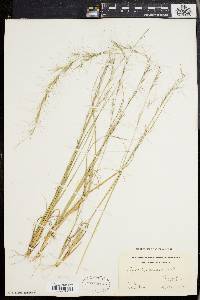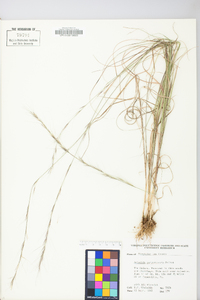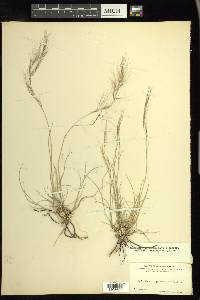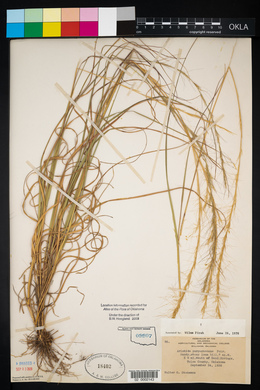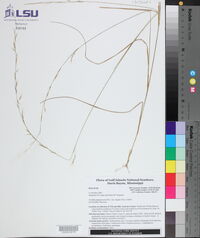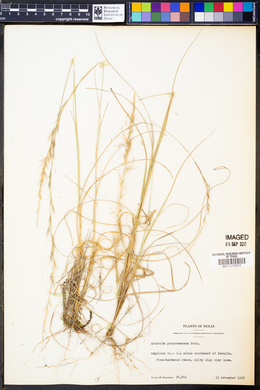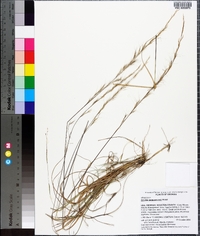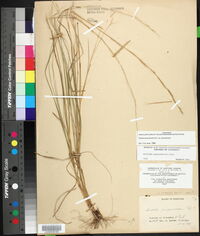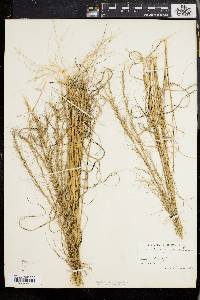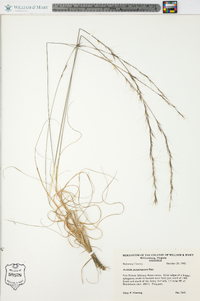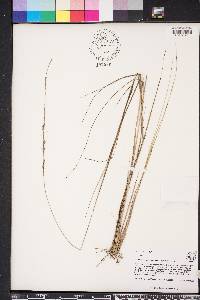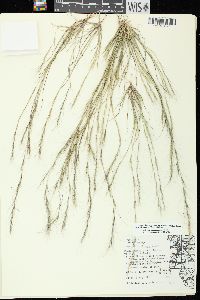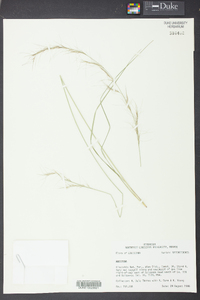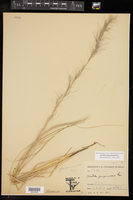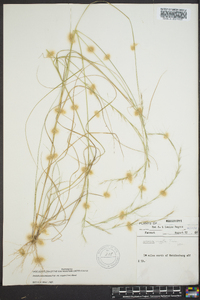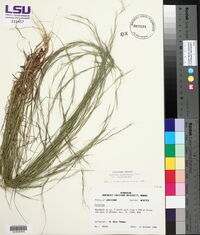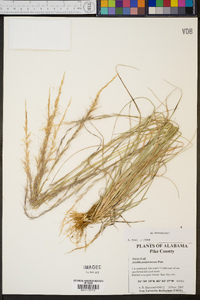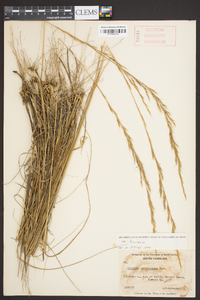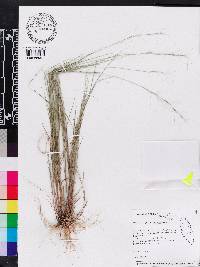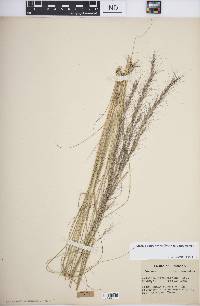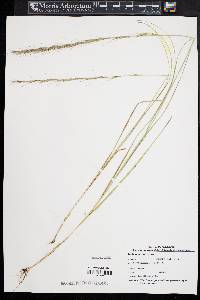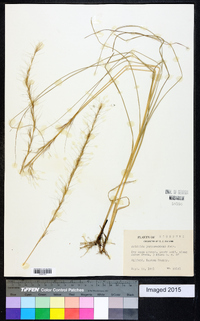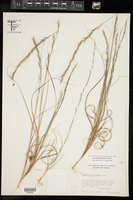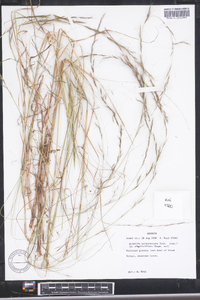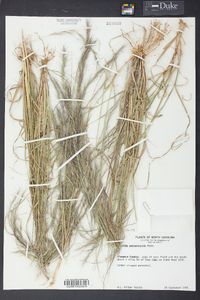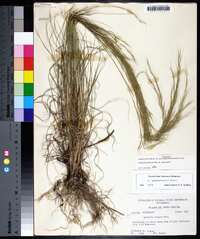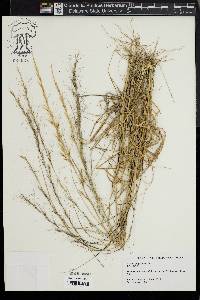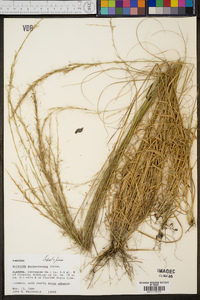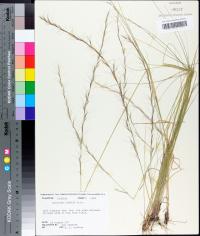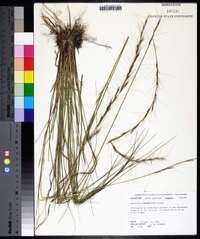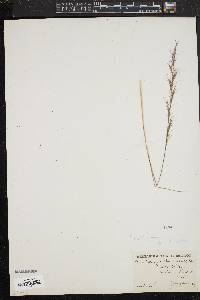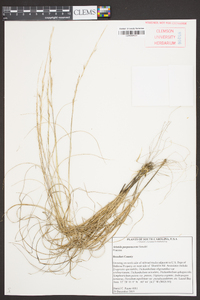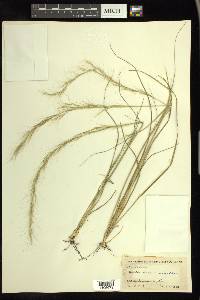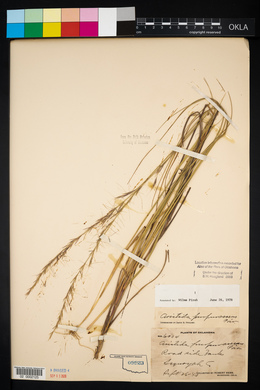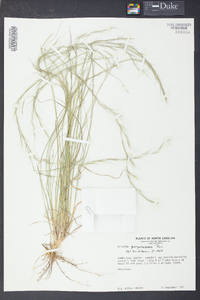Aristida purpurascens
|
|
|
|
Family: Poaceae
Arrow-Feather Three-Awn, more...arrowfeather threeawn
[Aristida elliotiana Steud., moreAristida geyeriana , Aristida purpurascens var. alabamensis Trin. & Rupr., Aristida purpurascens var. glaucissima , Aristida racemosa Muhl.] |
Plants perennial; cespitose, bases knotty, without rhizomes. Culms 40-100 cm tall, 1-4 mm thick at the base, erect, branching at the base, shoots becoming thickened and somewhat fan-shaped upwards. Leaves cauline; sheaths mostly longer than the internode, mostly or completely glabrous, sometimes pilose, particularly along the margins and at the throat, remaining intact at maturity; collars glabrous or pilose; ligules about 0.2 mm; blades 10-25 cm long, 1-3 mm wide, usually flat, usually lax, sometimes sinuous to curling at maturity, glabrous, pale green, drying brownish. Inflorescences paniculate, (15)20-55 cm long, 0.5-2(3) cm wide, often nodding; nodes glabrous, sometimes scabrous, lower nodes usually associated with more than 2 spikelets; primary branches 1-5 cm, tightly appressed to loosely ascending, without axillary pulvini, with 1-8 spikelets. Spikelets appressed. Glumes 5-10 mm, lower glumes from 3/4 as long as to 1-4 mm longer than the upper glumes, glabrous or sparsely appressed-pubescent, 1-2-veined, 1-keeled, tan to purplish, unawned or the awns no longer than 1 mm; calluses 0.4-0.8 mm; lemmas 4-8 mm, glabrous, mostly light tan or gray, often spotted or banded, beak not twisted, junction with the awns not evident; awns 8-25 mm, equal or subequal in length, curved, arcuate, or spirally coiled at the base, not disarticulating at maturity; central awns sometimes thicker than the lateral awns, erect to arcuate-reflexed; lateral awns straight and erect, ascending, or divergent; anthers 1 or 3, 1-1.5 mm, brown. Caryopses 3-5 mm, chestnut brown. 2n = unknown. Aristida purpurascens is composed of three intergrading varieties. Perennial tufted herb with a knotty base 40 cm - 1.55 m tall Leaves: borne along the culm, with open sheaths usually longer than the internodes and mostly hairless but sometimes soft-haired along the margins, throat, and collar. The ligules are made of hairs about 0.2 mm long, and the blades are pale green (brownish when dry), 10 - 25 cm long, 1 - 3 mm wide, usually flat, sometimes curving or curling when mature, and hairless. Inflorescence: terminal, 15 - 55 cm long, 0.5 - 3 cm wide, usually nodding, with hairless but sometimes rough nodes and 1 - 5 cm long primary branches. Fruit: a chestnut brown caryopsis, 3 - 5 mm long, spindle-shaped, with a linear scar. Culm: erect, 40 cm - 1 m tall, 1 - 4 mm across at the base, branching near the base. Spikelets: one to eight per branch, appressed. Glumes: tan to purplish, 5 - 10 mm long with the lower glume shorter than to 4 mm longer than the upper glume, thin, hairless or sparsely hairy, one- or two-veined, longitudinally ridged, and unawned or with awns shorter than 1 mm. Florets: one per spikelet, with one or three brown anthers 1 - 1.5 mm long. Lemma: usually light tan or gray, sometimes with spots or bands, 4 - 8 mm long, spindle-shaped, rolled up longitudinally (convolute), three-veined, hairless, with three nearly equal awns. The awns are 8 - 25 mm long, curved to arching or spirally coiled at the base, with the central awn sometimes thicker than the lateral ones. Palea: shorter than the lemma, two-veined. Similar species: Aristida tuberculosa is easily distinguished because its awns are twisted into an 8 - 15 mm column that separates into three straight awns at the top. Awns of Aristida oligantha are not twisted at the base and reach up to 7 cm in length. Aristida dichotoma has a 3 - 8 mm long central awn that is twisted at the base and 1 - 4 mm long lateral awns, while Aristida basiramea has a 10 - 15 mm long central awn that is twisted at the base and 5 - 10 mm long lateral awns. The central awn of Aristida longispica is 1 - 27 mm long and curved at the base, and the lateral awns (if present) reach 18 mm long. Flowering: late June to mid September Habitat and ecology: Sand barrens. Occurence in the Chicago region: native Etymology: Aristida comes from the Latin word arista, meaning awn. Purpurascens means purplish. Author: The Morton Arboretum Perennial 4-10 dm, tufted on a knotty base; lvs to 2 dm, mostly flat, 1-4 mm wide; lower sheaths covering the nodes, usually ±pilose; infl 1-2 dm, slender, loosely or densely spike-like, with short, ascending or appressed branches; glumes 1-veined, the first 8-14 mm, scabrous on the keel and sometimes on the sides, the second 6.5-11.5 mm, almost always exceeding the lemma and exceeded by the first glume; lemma 5.5-9.5 mm; awns about equally divergent, the central one 2-3.5 cm, the lateral 1.5-2.5 cm. Dry sandy soil and prairies; Mass. to s. Ont., Wis., and Kans., s. to Fla. and Tex. Gleason, Henry A. & Cronquist, Arthur J. 1991. Manual of vascular plants of northeastern United States and adjacent Canada. lxxv + 910 pp. ©The New York Botanical Garden. All rights reserved. Used by permission. From Flora of Indiana (1940) by Charles C. Deam Indiana Coefficient of Conservatism: C = 7 Wetland Indicator Status: FACU |
|
|
|

